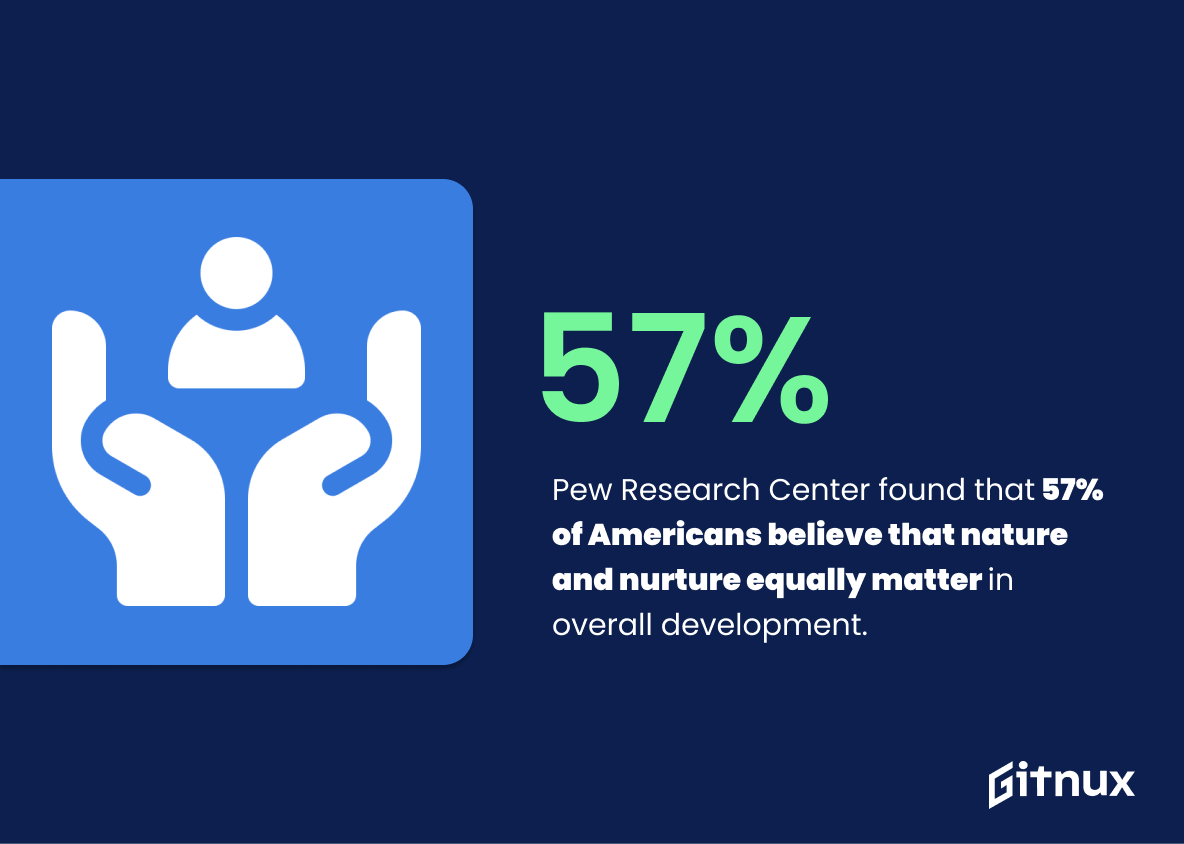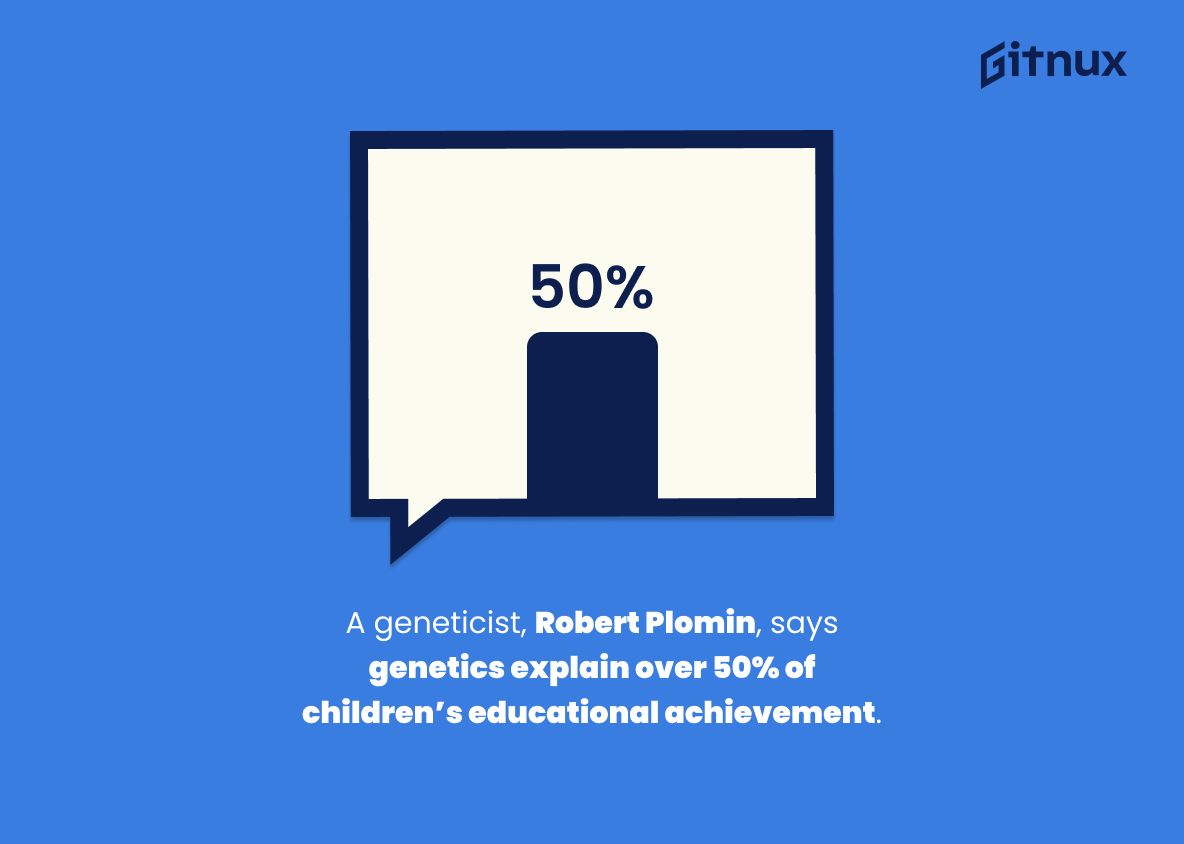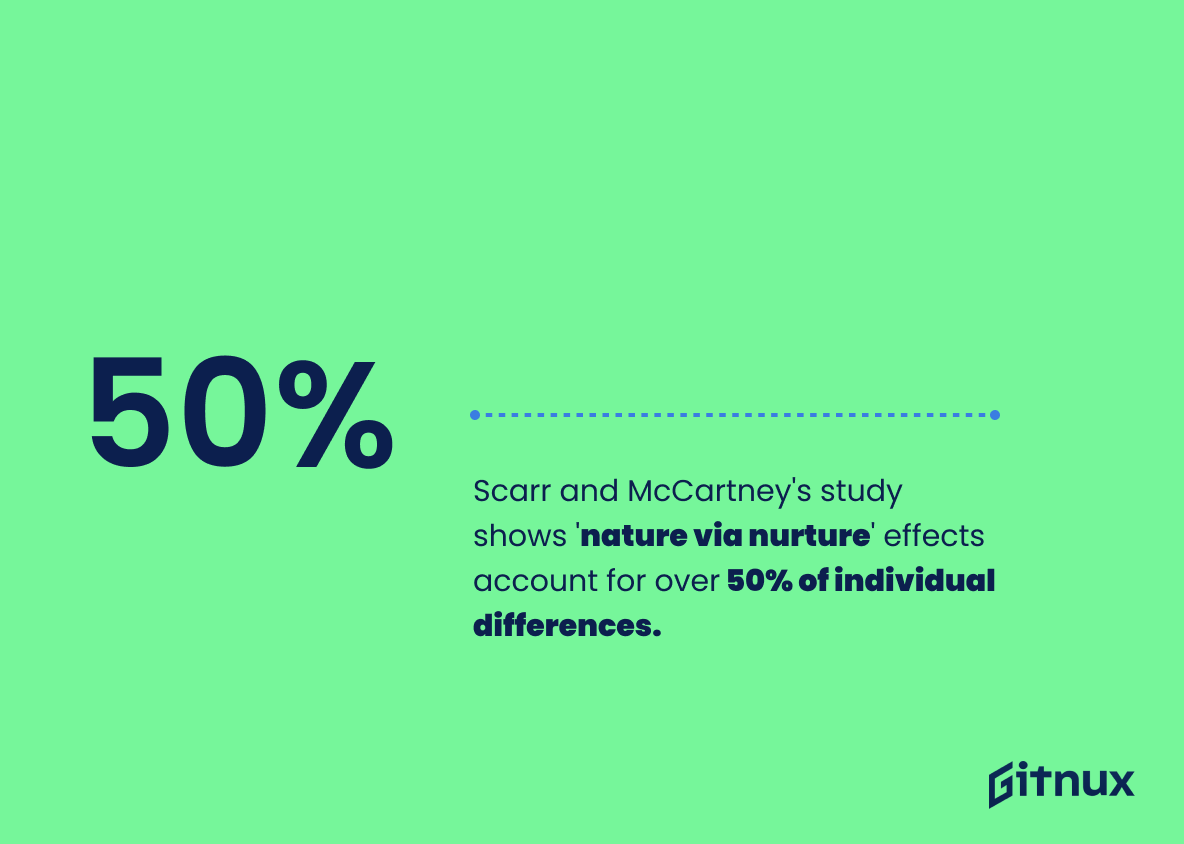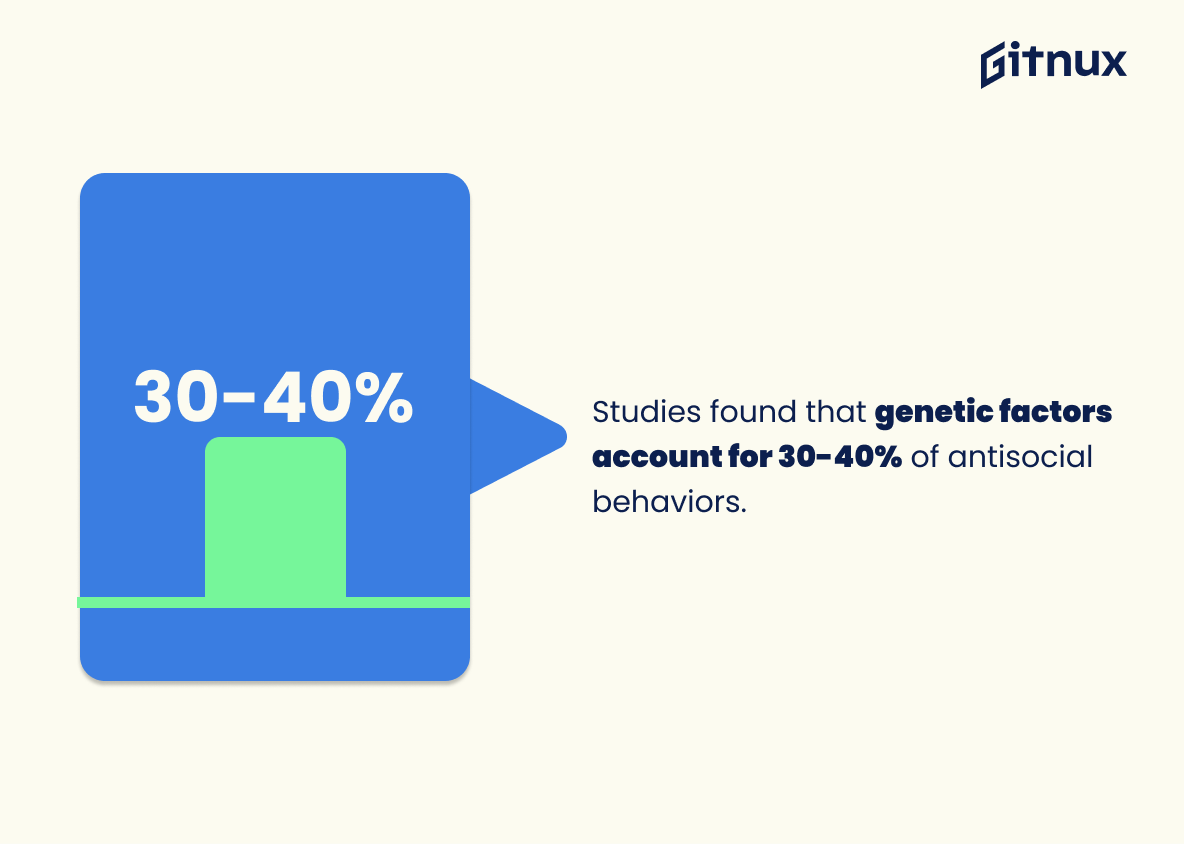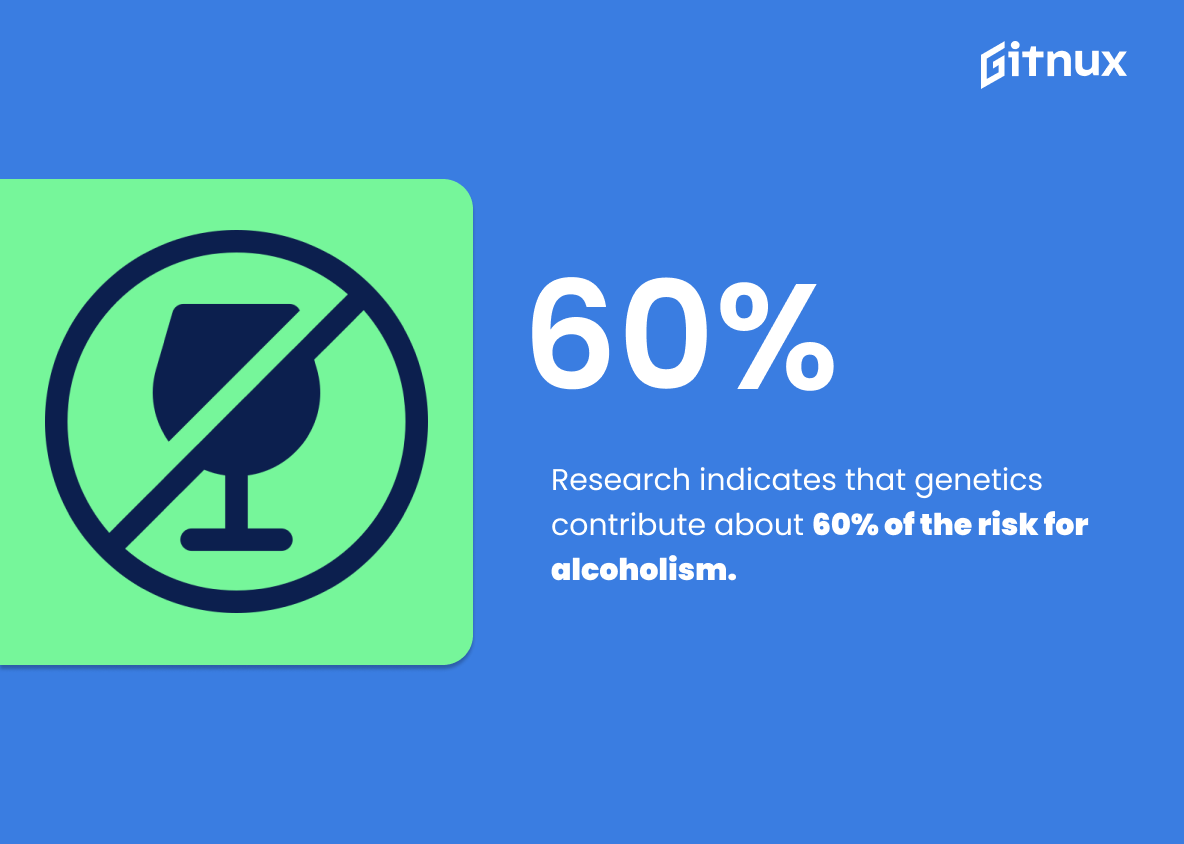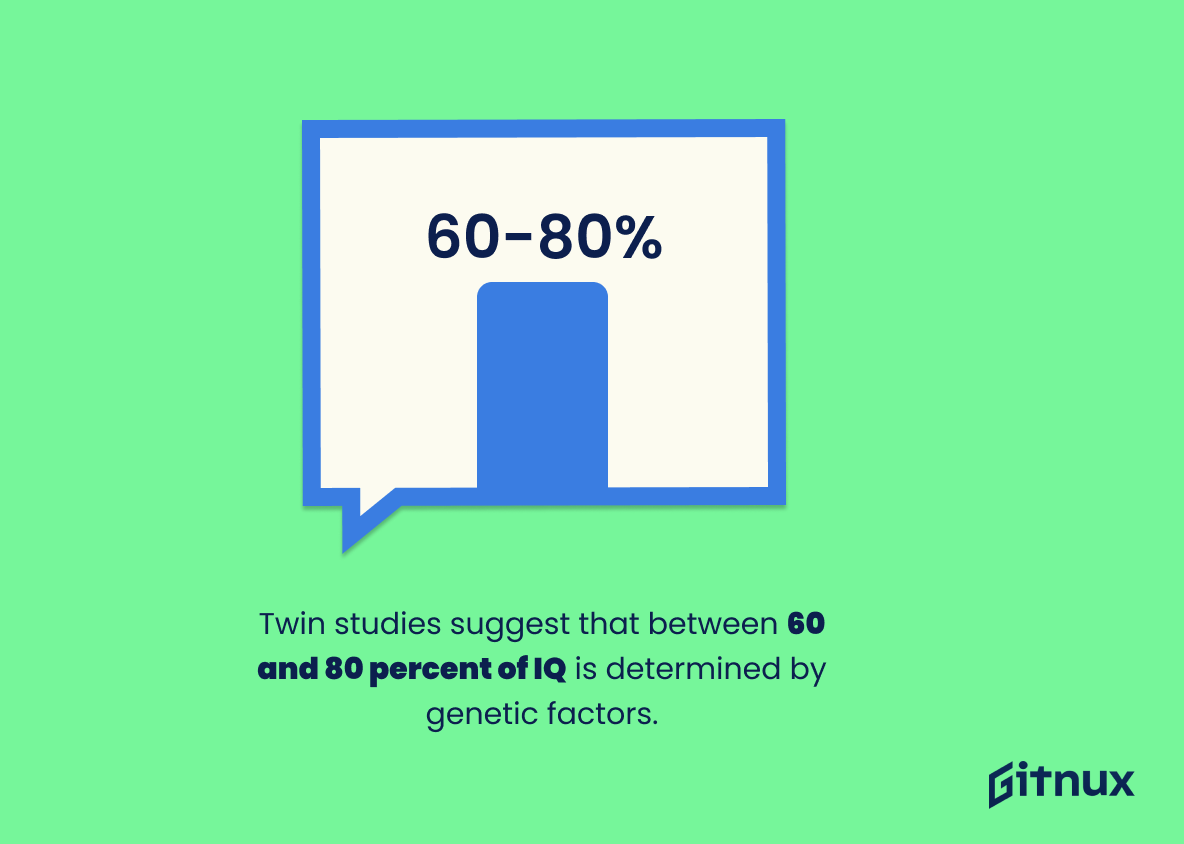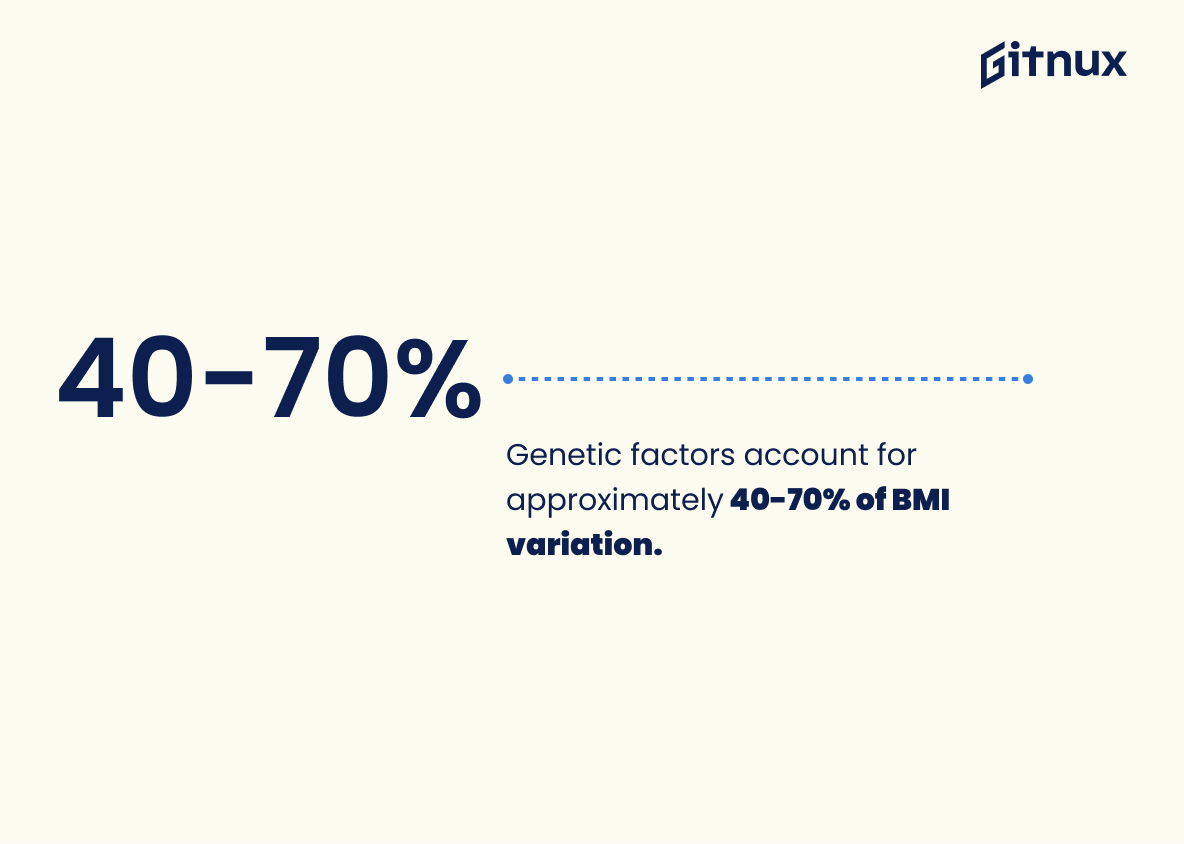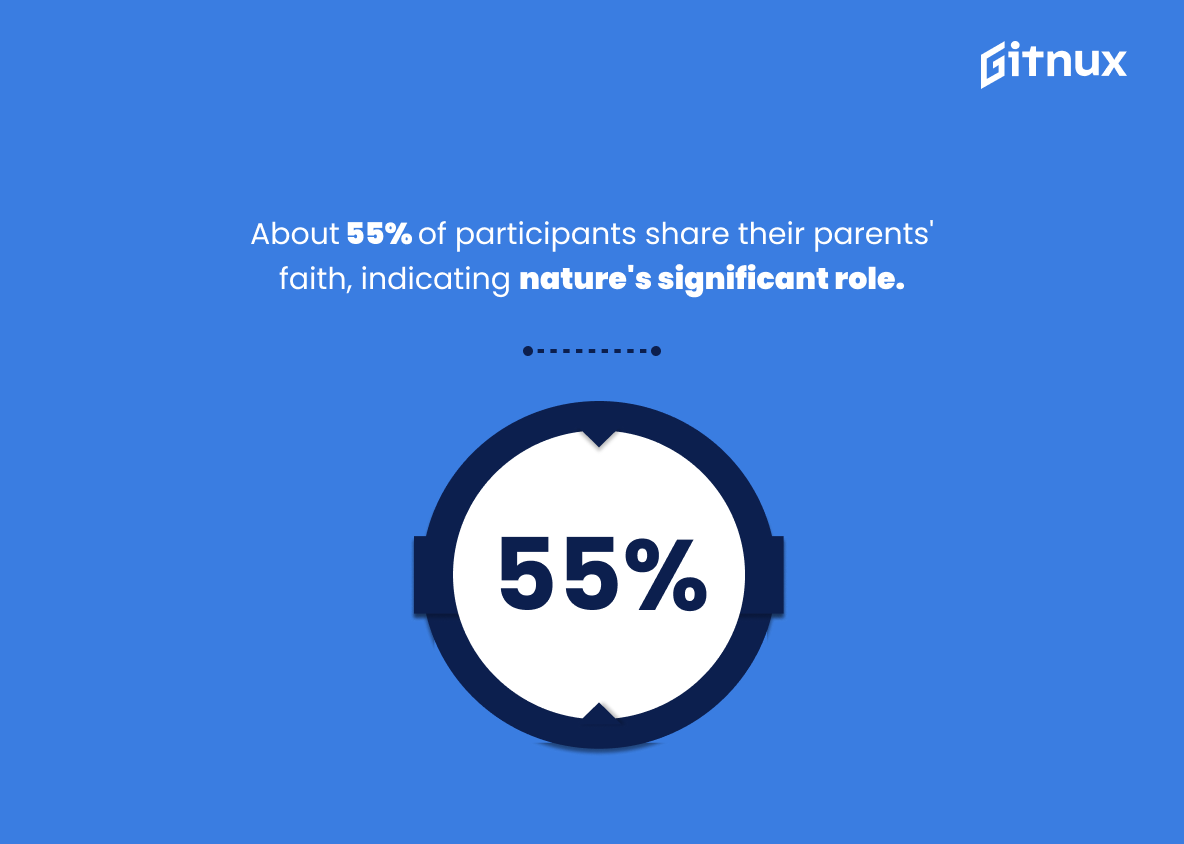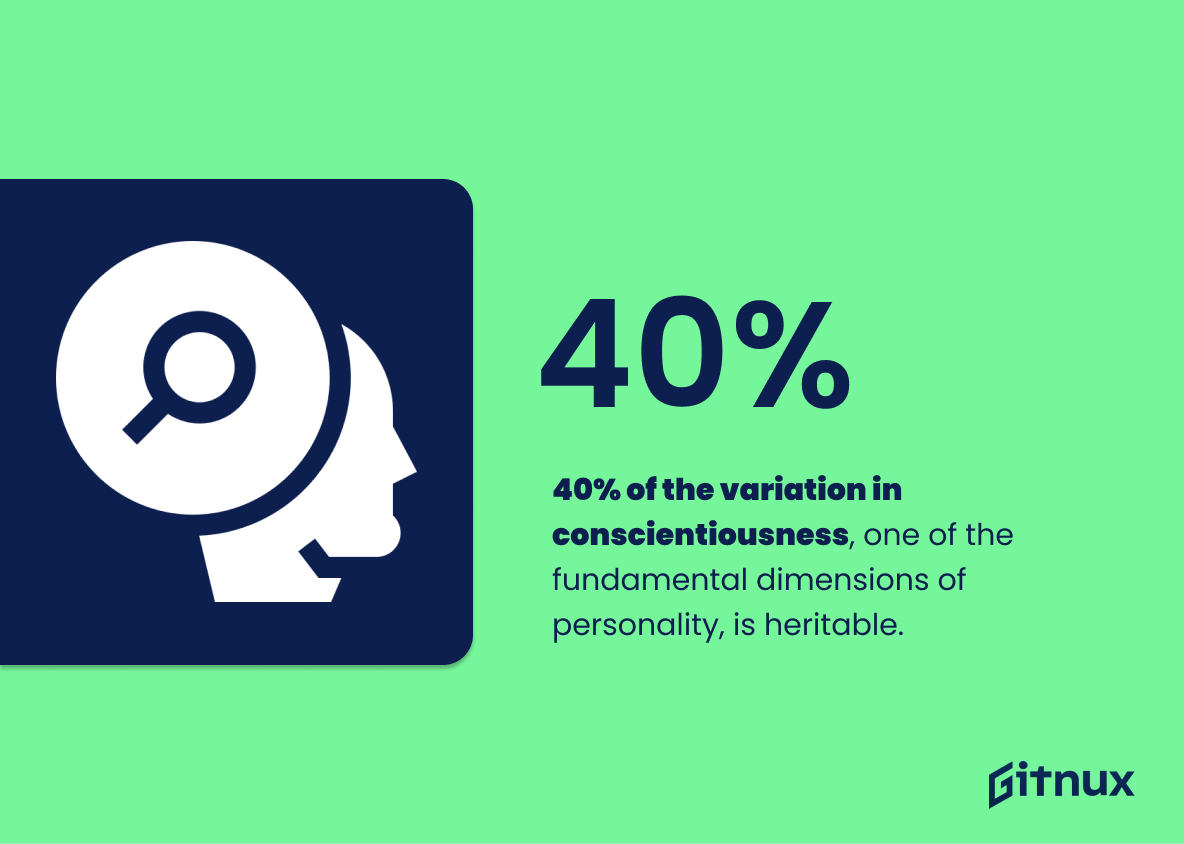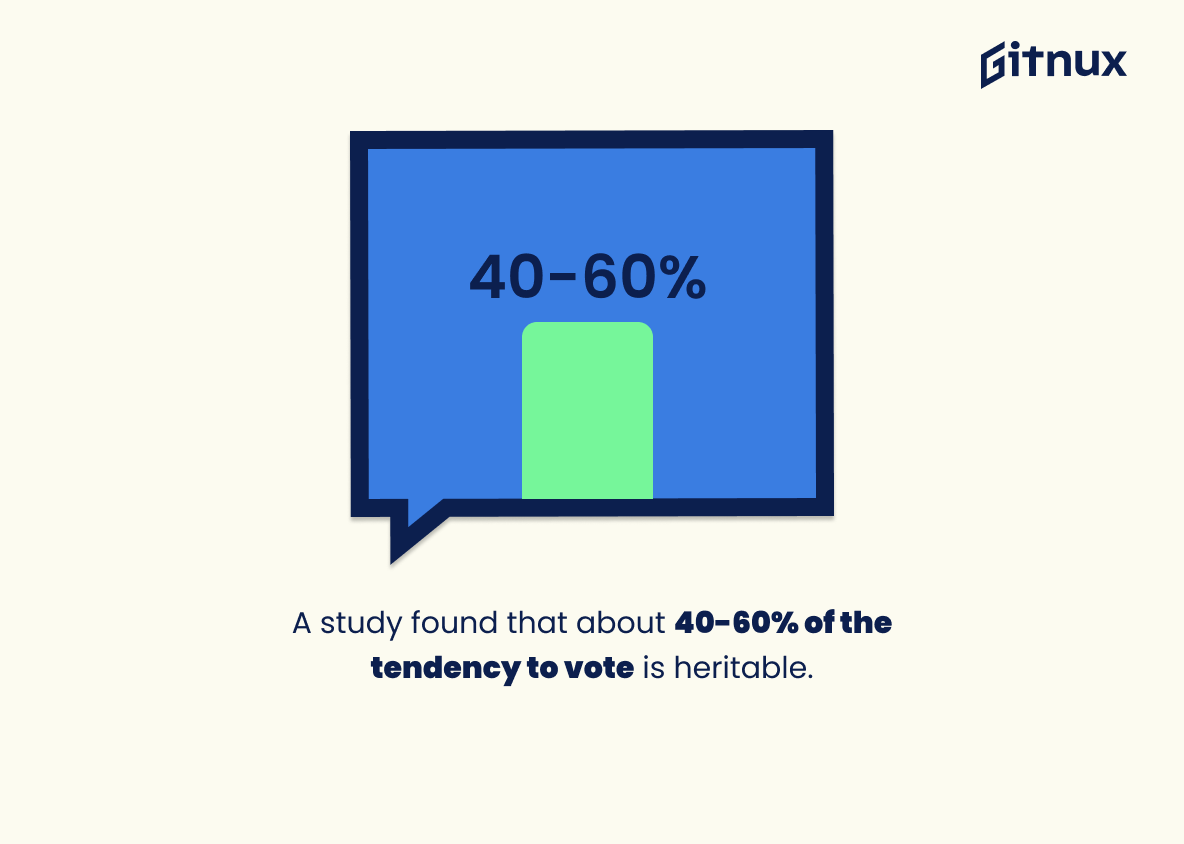Unraveling the mysteries of human behavior has been a long-standing debate pivoting around two dominant theories – nature and nurture. Our blog post today delves into the compelling world of Nature vs. Nurture statistics. As we engage in a meticulous exploration of these concepts, we’ll present pivotal research, revealing statistics, and thought-provoking insights that shine a light on the influence of genetic inheritance and environmental factors on human development and behaviour. Whether you’re a psychologist, a scholar, a student, or someone with a curiosity to understand more about human personality traits, this comprehensive coverage of nature vs nurture statistics promises to engage, educate and provide deeper understanding of this complex debate.
The Latest Nature Vs Nurture Statistics Unveiled
Pew Research Center found that 57% of Americans believe that nature and nurture equally matter in overall development.
In the Nature Vs Nurture debate, the compelling statistic from the Pew Research Center provides noteworthy evidence that a majority of Americans hold a balanced perspective. With 57% of individuals contending that both nature and nurture contribute equally to overall development, this showcases a significant amount of recognition for the potency of both genetic and environmental factors. Set against the backdrop of a blog post spotlighting Nature Vs Nurture Statistics, this particular finding enriches our understanding about public beliefs and assumptions surrounding this ongoing debate. Being privy to such insights broadens our knowledge and opens up further dialogues and discussions on the intricacies and interplay of our genes and our environments – ultimately, advancing the narrative of this age-old discourse.
A leading behavioral geneticist, Robert Plomin, concludes that genetic influence accounts for over 50% of the difference in children’s educational achievement.
In piecing together the elaborate jigsaw puzzle of Nature Vs Nurture, the insights provided by Robert Plomin, a decorated behavioral geneticist, serve as a crucial missing piece. His conclusion that genetics contribute to over 50% of the variance in children’s educational accomplishments sheds light on the influential role that DNA strands play in shaping an individual’s academic journey. No longer can we solely attribute academic aptitude to environmental factors and upbringing; the contribution from genetics is unmistakably significant. Thus, in the broader conversation of Nature Vs Nurture, Plomin’s research accentuates the necessity to balance both sides of the equation, illuminating that our learning capabilities are partially prewritten in our genetic codes. This information prompts not only an enriched examination of genetic influences but also a refined understanding of how nature intertwines with nurture.
According to Scarr and McCartney’s genotype-environment interaction and correlation study, ‘nature via nurture’ effects represent more than 50% of individual differences.
Anchor your understanding on this crucial statistic: Scarr and McCartney’s genotype-environment interaction study showcases more than 50% of individual differences are the result of ‘nature via nurture’ effects. While delving into the timeless debate of nature versus nurture, it elucidates an intriguing truth. It emphasizes an incredible blend, a co-existence, a symphony, if you may, between genetic makeup (nature) and environmental influence (nurture) in shaping an individual’s development. This measured insight challenges the polarized viewpoint, saturating the conversation around this dichotomy, offering a more nuanced perspective. Such invaluable statistical representation plays a fundamental role in this discourse, emphasizing that human development is indeed an elegant dance between nature and nurture. It stimulates the readers to venture beyond partially blind and limiting debates and catalyzes a comprehensive understanding of human development through the lens of statistical evidence.
Studies found that genetic factors account for 30-40% of antisocial behaviors.
While exploring the ongoing debate of Nature versus Nurture, this intriguing statistic acts as a compass, pointing towards the significant influence of genetic factors on antisocial behaviors. It carves out a terrain where genetics is responsible for approximately one-third to nearly half of such behaviors, underscoring the ‘Nature’ side of the equation. However, it also leaves an interesting unexplored territory – the remaining 60-70%, pushing us to consider the potentially pivotal role of environment and upbringing, the ‘Nurture’ aspect. In the labyrinth of this complex discussion, such statistics function as guiding lights, highlighting the intricate interplay between our genes and our environment in shaping who we are.
Concordance rates for homosexuality are 20-50% for identical twins and around 0-20% for non-identical twins.
Delving into the intricate interplay of nature versus nurture, this statistic presents a compelling layer to the argument. It spellbindingly paints a picture of how our genes and environment collectively influence our sexuality. The significant disparity in concordance rates between identical and non-identical twins could suggest the role of genetics in determining homosexuality. However, the fact that the concordance rate is not 100% for identical twins, who share the same genetic blueprint, implies that other factors, possibly environmental, may also be at play. Thus, this statistic provides a nuanced insight into the complexity of human sexuality, reinforcing that it’s not a case of nature or nurture but confluence of both that shape us.
Research indicates that genetics contribute about 60% of the risk for alcoholism.
In the perpetual debate of Nature vs Nurture, the statistic casting genetics as a 60% contributor to the risk of alcoholism shines a compelling light on the “Nature” side of the argument. It unravels an intriguing narrative that implies our genes may wield a more substantive influence than environmental factors when it comes to alcoholism vulnerability. This percentage underscores the pivotal role that genetic makeup plays in determining one’s predisposition to addiction, serving as a stark reminder that we are, in part, our biology. Quite fascinatingly, this statistic also opens up a dialogue about the remaining 40%. It creates room for further exploration on how environmental factors or ‘nurture’ complements our genetic predisposition and shapes the overall trajectory of alcoholism.
Twin studies suggest that between 60 and 80 percent of IQ is determined by genetic factors.
Navigating the intricate maze of the enduring Nature Vs Nurture debate, the statistic that twin studies suggest between 60 to 80 percent of IQ is determined by genetic factors is a lighthouse guiding the ship of understanding. It advances not just the argument for genetic determinism but carves the path that leads us to examine how much our gray matter owes to the twisting double helix of our DNA. This statistic, emanating from twin studies, is a flashing neon sign highlighting the essentially genetic underpinnings of human intelligence. Highlighting the potential core role of nature, it challenges us to reconsider the impact of nurture on the development of our cognitive prowess. In the chess game of human behavior and intellect development, it’s a bold opening move by Team Genes, pushing Team Environment to formulate a well-calculated response. Fundamentally, it offers valuable fodder for the ongoing dialogue and unending exploration that beats at the heart of this complex dilemma of Nature Vs Nurture.
Genetic factors account for approximately 40-70% of BMI variation.
Positioned at the crux of the ancient nature versus nurture debate, this statistic unveils an intricate weave of our genetic blueprint and lifestyle choices on our Body Mass Index (BMI). It provides a quantitative glimpse into how our genes, the very strands of instructions inherited from our parents, contribute to 40-70% of our BMI variation, a key indicator of our body fat.
In the unfolding saga of this discourse, nature is attributed as having an assertive, albeit not the entirety, influence on our physical makeup as indicated by our BMI. Our nurture, or environment and lifestyle, thus fills out the remainder of this influence. Hence, shaping the way we comprehend the composition of our physicality and directing possible prevention and intervention measures of obesity.
In essence, nature and nurture are not mutually exclusive rivals, but rather cooperative players in the theater of our bodily health, with the former laying the foundation and the latter providing the finishing touch, as quantitatively depicted by this statistic.
Research suggests that 74% of depression cases can be explained by genetic factors.
Draping this statistic in the spotlight, we comprehend the intensity of the nature versus nurture debate. Adopting an understanding that 74% of depression cases may be genetically linked provides a robust viewpoint towards the ‘nature’ element of human behavior. It asserts that our genes play a considerable role in dictating our mental health status, underscoring the power of inherent factors over our environment or upbringing. With this revelation, the post can promote enlightened discussions, challenge preconceived notions about depression, and guide towards a more nuanced approach in treating or preventing this condition.
A study found that about 55% of participants have a faith that is similar to their parents, hinting nature has a significant role.
Shining a light on the competing forces of nature versus nurture, this captivating statistic – that about 55% of participants share a similar faith to their parents – delicately underscores the potent influence of genetic predispositions. Indeed, more than half of individuals appear to spiritually align with their parents, suggesting that the seeds of faith might be nestled within our DNA as much as they are nurtured within our homes. This inherent affinity towards parental beliefs highlights the fascinating interplay between inherited characteristics and environmental factors, central themes in any discussion around the nature versus nurture debate. Therefore, in the vivid tapestry of Nature Vs Nurture Statistics, this measurement serves as an intriguing thread that weaves the intricate dance of genetics and environment into a coherent story.
40% of the variation in conscientiousness, one of the fundamental dimensions of personality, is heritable.
In the perennial debate of nature versus nurture, the discovery that 40% of the variability in conscientiousness is due to heredity sprinkles a layer of evidence onto the genetic side of the scale. This percentage escapes the notion of personality being a blank canvas, shaped solely by life experiences and environment, underscoring the genetic brushstrokes shaping who we are. It propels us to reconsider our understanding of personality traits like conscientiousness, traditionally viewed within the purview of environmental influences. It undoubtedly reaffirms the argument that our genes play an intricate, and perhaps underestimated, role in carving out our personality’s contours. While this certainly doesn’t discount the integral role of nurture, it effectively challenges the belief in its sovereignty over nature in shaping who we are.
A study found that about 40-60% of the tendency to vote is heritable.
Embedded within the intriguing fabric of the Nature Vs Nurture debate, the statistic – a study revealing that 40-60% of the voting tendency is heritable – holds a compelling significance. In the ceaseless dance between our genetic makeup and our environmental influences, this statistic brings an unexpected partner to the floor: our political inclinations. It introduces a captivating twist to the conversation.
Firstly, it offers an unexpected insight into how profoundly our genetic makeup can shape our behaviors – even those we might commonly perceive as entirely nurture-oriented, like political leanings. Thus, delving into the realm of voting behavior being influenced by genetic predispositions unveils how intricately woven those tendencies are into our identity by the loom of nature.
Secondly, it underlines the complexity of humans, driving home the message that we are not merely blank canvases to be painted by our environment, nor pre-determined scripts authored solely by our DNA. Instead, we are living interplays, thus, the statistic serves as an exciting reminder of this fascinating interplay between ‘Nature’ and ‘Nurture’.
In the context of a blog post about Nature Vs Nurture Statistics, this revelation underscores the imperative to approach assumed ‘Nurture’ aspects of human behavior with a more nuanced perspective, to consider the subtle dances that our genes may be leading in the background. In essence, it gives the readers a fresh lens through which to ponder this age-old debate.
The heritability of stress reaction is estimated to be 32-35% based on twin studies.
Delving into the captivating world of nature vs. nurture debate, we stumble upon a fascinating statistic: ‘the heritability of stress reaction is estimated to be 32-35% based on twin studies.’ This numerical fact acts as the linchpin, bolstering our understanding of the proportion of variances in people’s stress reactions that can be traced back to genetic factors. It acts as the quantifiable measure in the ongoing seesaw battle between innate predispositions and environmental influences. Like a compass, it orients readers, underscoring the profound impact our genetic blueprint has in shaping how we respond to stress, subtly reminding us that the nature side of our personal equation has more sway that we might have presumed. A post about Nature vs. Nurture would thus feel incomplete without this statistic, a potent proxy for the magnitude of nature’s influence.
Conclusion
In the perennial debate of nature versus nurture, statistics provide a key insight. They illuminate the intricate interplay of our genetic blueprint and environmental influences in shaping who we are. While genetics predispose us to certain traits and behaviors, our environment and experiences significantly contribute to our development and can alter the course of our lives. To say one holds dominance over the other would be oversimplifying an incredibly intricate process. In reality, nature and nurture work synchronously, sculpting us into the individuals we ultimately become. In the realm of human development, it would seem there is no clear winner in the nature versus nurture debate — both are victorious in their intertwined influence on human life.
References
0. – https://www.www.sscnet.ucla.edu
1. – https://www.pubmed.ncbi.nlm.nih.gov
2. – https://www.www.scientificamerican.com
3. – https://www.www.niaaa.nih.gov
4. – https://www.www.ncbi.nlm.nih.gov
5. – https://www.www.jstor.org
6. – https://www.www.pewforum.org
7. – https://www.www.pewsocialtrends.org
